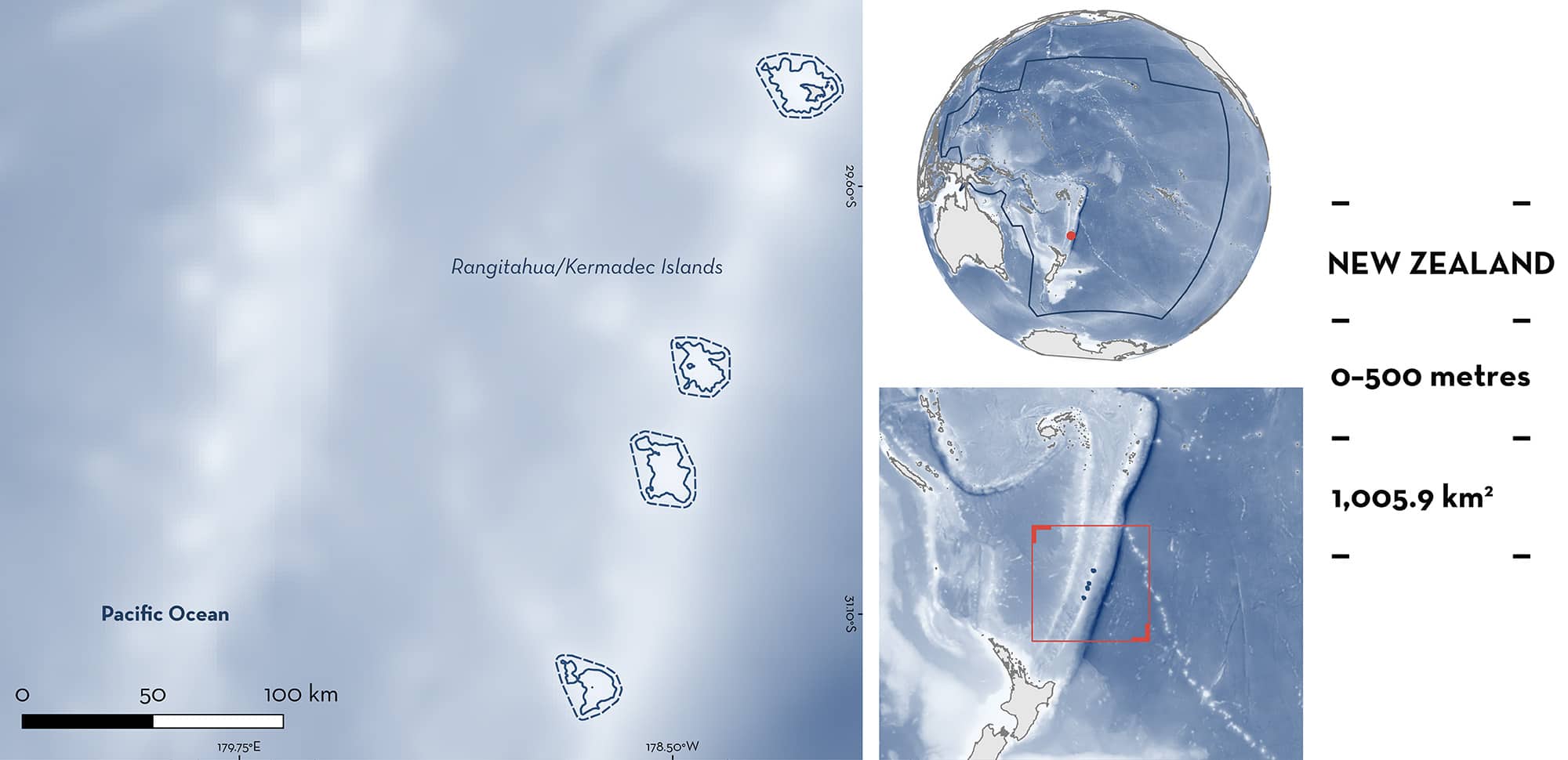ISRA FACTSHEETS
ISRA FACTSHEETS
NEW ZEALAND & PACIFIC ISLANDS REGION
Rangitahua/Kermadec Islands
Summary
Rangitahua/Kermadec Islands is located ~800 km northeast from North Island of New Zealand. The area is a chain of subtropical and volcanic islands (Raoul, Meyer, Macauley, Curtis, Cheeseman, Herald Islets, L’Esperance Rock, and L’Havre Rock) situated in the Kermadec Ridge. The area is characterised by the presence of multiple seamounts with sandy, rocky, and muddy substrates. The area overlaps with the Kermadec (offshore) Key Biodiversity Area and with the Kermadec Islands Marine Reserve. Within the area there are: range-restricted species (Kermadec Spiny Dogfish Squalus raoulensis) and reproductive areas (Galapagos Shark Carcharhinus galapagensis).
Download factsheet
Rangitahua/Kermadec Islands
DESCRIPTION OF HABITAT
Rangitahua/Kermadec Islands is located ~800 km northeast of the North Island of New Zealand. The area includes a chain of subtropical volcanic islands situated in the Kermadec Ridge. From north to south, it includes Raoul Island (the largest island), Meyer Island, Herald Islets, Macauley Island, Curtis and Cheeseman Islands, L’Esperance Rock, and L’Havre Rock (Francis et al. 1987). The area is characterised by the presence of multiple seamounts around the ridge with sandy, rocky, and muddy substrates along coral patches and a high diversity of crinoids (Duffy & Ahyong 2015). Shallow subtidal habitats include a mixture of sandy and rocky substrates, and slope habitats include active hydrothermal vent systems, deep reefs, talus fields, as well as sandy and muddy substrates (Duffy & Ahyong 2015). Surface oceanography is dominated by the South Pacific Subtropical Gyre (Sutton et al. 2012). Sea surface temperatures range from ~17°C (August) to ~25°C (February) with mean temperatures dropping to ~15°C at 200 m and to ~10°C at 400 m depths (Sutton et al. 2012).
The area overlaps with the Kermadec (offshore) Key Biodiversity Area (KBA 2024). It also overlaps with the Kermadec Islands Marine Reserve (UNEP-WCMC & IUCN 2024).
This Important Shark and Ray Area is benthic and pelagic and is delineated from surface waters (0 m) to 500 m based on the depth range of the Qualifying Species of the area.
CRITERION B
RANGE RESTRICTED
This area holds the regular presence of the Kermadec Spiny Dogfish as a resident range-restricted species. The Kermadec Spiny Dogfish is endemic to the Kermadec Islands and was described from three individuals collected in the Kermadec Islands before 2007 (Duffy & Last 2007). Since its description, multiple individuals have been recorded in different islands within Rangitahua/Kermadec Islands. Five individuals were recorded in Raoul, Cheeseman, and Curtis Islands in 2011 (Trnski et al. 2015), and three were recorded in Macauley Island in 2016 between 125–288 m depths (Clark et al. 2017). Additional individuals have been collected in all the area with southern records found at L’Havre Rocks (CAJ Duffy unpubl. data 2024). The species has not been observed in any other site globally, and not even on Star of Bengal Bank, ~100 km south of the area during sampling in 2016. The Kermadec Spiny Dogfish does not occur in any Large Marine Ecosystem but has a very small area of occurrence.
CRITERION C
SUB-CRITERION C1 – REPRODUCTIVE AREAS
Rangitahua/Kermadec Islands is an important reproductive area for one shark species.
Galapagos Sharks are abundant throughout the archipelago, but observations of adults are infrequent (Duffy 2016). In 2011, 76 Galapagos Sharks were observed at 10 locations between Raoul Island and L’Esperance Rock with estimated sizes between 80–180 cm total length (TL; mean = 125 cm TL; CAD Duffy unpubl. data 2024). In addition, 18 Galapagos Sharks were caught and measured during the same expedition ranged from 84.5–149 cm TL (mean = 116 cm TL; CAD Duffy unpubl. data 2024). Size-at-birth for the species is 57–81 cm TL (Wetherbee et al. 1996; Ebert et al. 2021) confirming that some of these individuals were young-of-the-year. Additionally, historical records since 1908 include observations of juveniles Galapagos Sharks around Raoul Island during summer in nearshore habitats (Waite 1909). In 1974, two specimens were recorded, a 79.2 cm TL male caught at 38 m depth off Macauley Island and a 113.5 cm TL female caught in 18–23 m depth off Curtis Island (Garrick 1982). This species lives around the island and does not inhabit oceanic waters (Ebert et al. 2021) making Rangitahua/Kermadec Islands the only suitable habitat for reproduction.
Download factsheet
SUBMIT A REQUEST
ISRA SPATIAL LAYER REQUEST
To make a request to download the ISRA Layer in either a GIS compatible Shapefile (.shp) or Google Earth compatible Keyhole Markup Language Zipped file (.kmz) please complete the following form. We will review your request and send the download details to you. We will endeavor to send you the requested files as soon as we can. However, please note that this is not an automated process, and before requests are responded to, they undergo internal review and authorization. As such, requests normally take 5–10 working days to process.
Should you have questions about the data or process, please do not hesitate to contact us.


